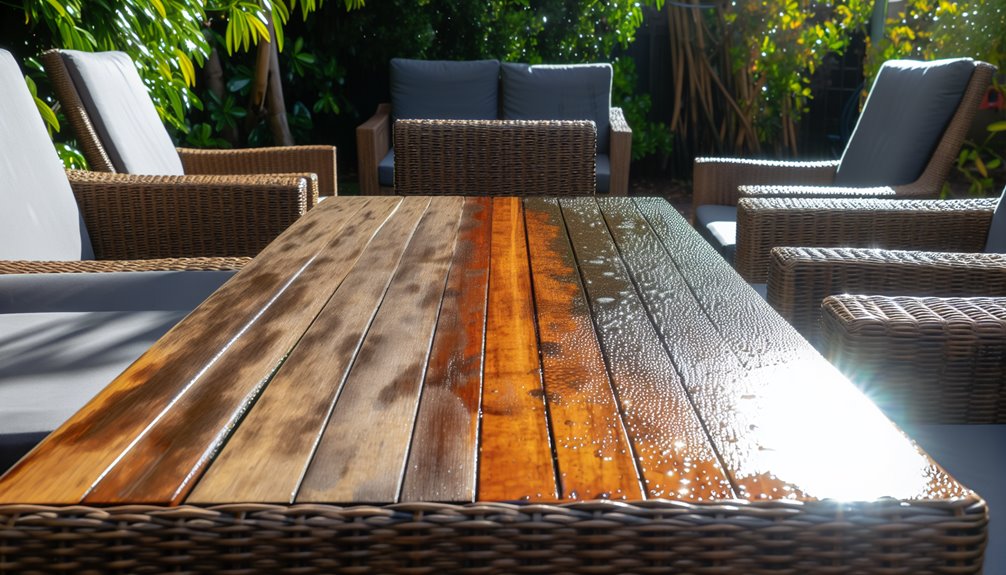
Outdoor furniture often endures harsh weather conditions, leading to deterioration over time. Pressure washing emerges as a vital method for restoring these pieces to their former glory. This technique not only eliminates built-up dirt and mold but also extends the life of materials like wood and metal. Understanding the nuances of outdoor furniture restoration washing can make a significant difference. What steps should one take to ensure effective restoration?
Key Takeaways
- Pressure washing effectively removes dirt, grime, and mildew, restoring the original appearance of outdoor furniture.
- Using biodegradable cleaning solutions ensures safe and effective cleaning without harming the environment.
- Regular pressure washing extends the lifespan of materials like wood and metal by preventing deterioration.
- Proper preparation and equipment selection enhance the cleaning process and achieve optimal results.
- Maintaining cleaned furniture with protective sealants and covers helps preserve its restored condition.
Understanding Pressure Washing and Its Benefits
While many homeowners overlook the importance of maintaining their outdoor furniture, understanding pressure washing and its benefits can significantly enhance the longevity and appearance of these pieces.
Pressure washing effectively removes dirt, grime, mold, and mildew that accumulate over time, ensuring furniture looks fresh and inviting. This method not only revitalizes surfaces but also prevents deterioration, extending the lifespan of materials like wood, metal, and synthetic fibers.
Moreover, pressure washing can save time and effort compared to manual cleaning methods. By investing in this maintenance practice, homeowners can enjoy their outdoor spaces with confidence and preserve their furniture’s aesthetic appeal.
Preparing Your Outdoor Furniture for Pressure Washing
Before diving into pressure washing, homeowners must ensure their outdoor furniture is properly prepared to achieve the best results.
First, they should remove cushions and any accessories, protecting them from water damage.
Next, a thorough inspection for loose parts or rust is essential; tightening screws and treating rust will enhance longevity.
Cleaning off debris, like dirt and leaves, will prevent clogging during washing.
Lastly, positioning the furniture away from delicate plants or surfaces helps avoid unintended damage.
Choosing the Right Equipment and Cleaning Solutions
Choosing the right equipment and cleaning solutions is crucial for effectively restoring outdoor furniture, as the wrong tools can lead to damage or inadequate results.
A pressure washer with adjustable settings allows for tailored cleaning based on the furniture material, whether it’s wood, metal, or plastic. Selecting biodegradable cleaning agents ensures both effectiveness and environmental safety.
For stubborn stains, specialized solutions may be necessary, but they should be tested on inconspicuous areas first. Additionally, using durable brushes and nozzles can enhance cleaning efficiency.
Step-by-Step Guide to Pressure Washing Outdoor Furniture
Pressure washing outdoor furniture can be a game changer in restoring its original beauty and prolonging its lifespan.
First, gather all necessary equipment, including a pressure washer, cleaning solution, and protective gear. Next, remove any loose debris and cushions.
Adjust the pressure settings to avoid damage, usually between 1200-2000 PSI. Apply the cleaning solution evenly, letting it sit for a few minutes. Rinse thoroughly, ensuring no soap residue remains.
For stubborn stains, use a soft brush during washing. Finally, let the furniture dry completely in a shaded area before using it again.
This method ensures a fresh, revitalized outdoor space.
Tips for Maintaining Your Restored Furniture After Cleaning
Once outdoor furniture has been restored and cleaned, maintaining its appearance and durability becomes essential to ensure it lasts for years.
Regularly inspect the furniture for signs of wear, and clean it with mild soap and water to prevent grime buildup.
Applying a protective sealant or oil can enhance resistance against the elements.
Store furniture in a dry, sheltered area during harsh weather to minimize damage.
Use cushions and covers to protect from sun exposure and moisture.
Frequently Asked Questions
How Often Should I Pressure Wash My Outdoor Furniture?
Experts recommend pressure washing outdoor furniture annually, depending on exposure to elements. Regular cleaning helps maintain appearance and longevity, preventing buildup of dirt and mildew. For optimal results, the frequency may increase in harsher climates.
Can Pressure Washing Damage Certain Types of Furniture Materials?
When pressure washing, one must tread carefully; delicate woods and certain metals can be easily harmed. It’s crucial to know each material’s limits, ensuring the furniture remains a cherished part of the outdoor oasis.
Is It Safe to Pressure Wash Painted or Stained Surfaces?
When considering pressure washing painted or stained surfaces, one should exercise caution. It’s possible for high pressure to strip paint or stain, so using a lower setting and testing a discreet area is advisable for safety.
What Should I Do if My Furniture Has Mold or Mildew?
When 80% of outdoor furniture faces mold or mildew issues, proper care’s essential. He should start by gently scrubbing with a mixture of soap and water, ensuring thorough drying to prevent future growth and maintain aesthetics.
How Long Does It Take for Outdoor Furniture to Dry After Washing?
After washing outdoor furniture, it typically takes about 2 to 6 hours to dry, depending on the material and weather conditions. He or she should ensure proper airflow to facilitate quicker drying and prevent mold growth.
Conclusion
In conclusion, the transformation of weathered outdoor furniture from dull and grimy to vibrant and inviting is nothing short of remarkable. With pressure washing, one can effectively rejuvenate materials that once seemed beyond repair, restoring their original beauty and functionality. By investing the time and effort into this cleaning process, homeowners not only enhance their outdoor aesthetics but also protect their furniture from future wear. Ultimately, the contrast between neglect and care illustrates the profound impact of proper maintenance.